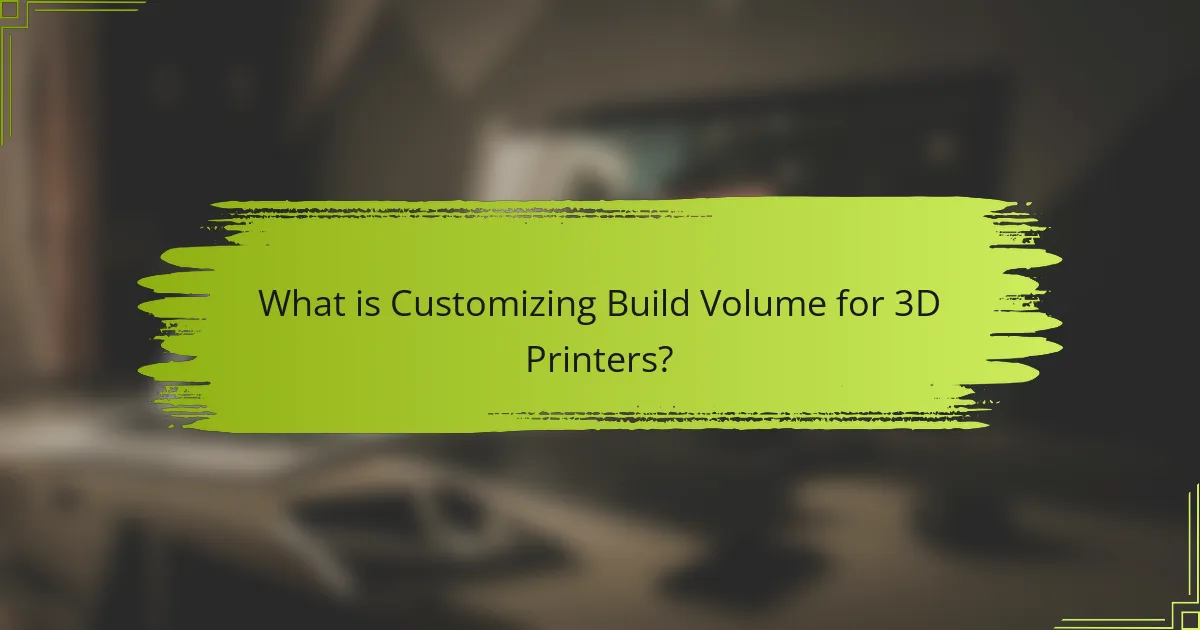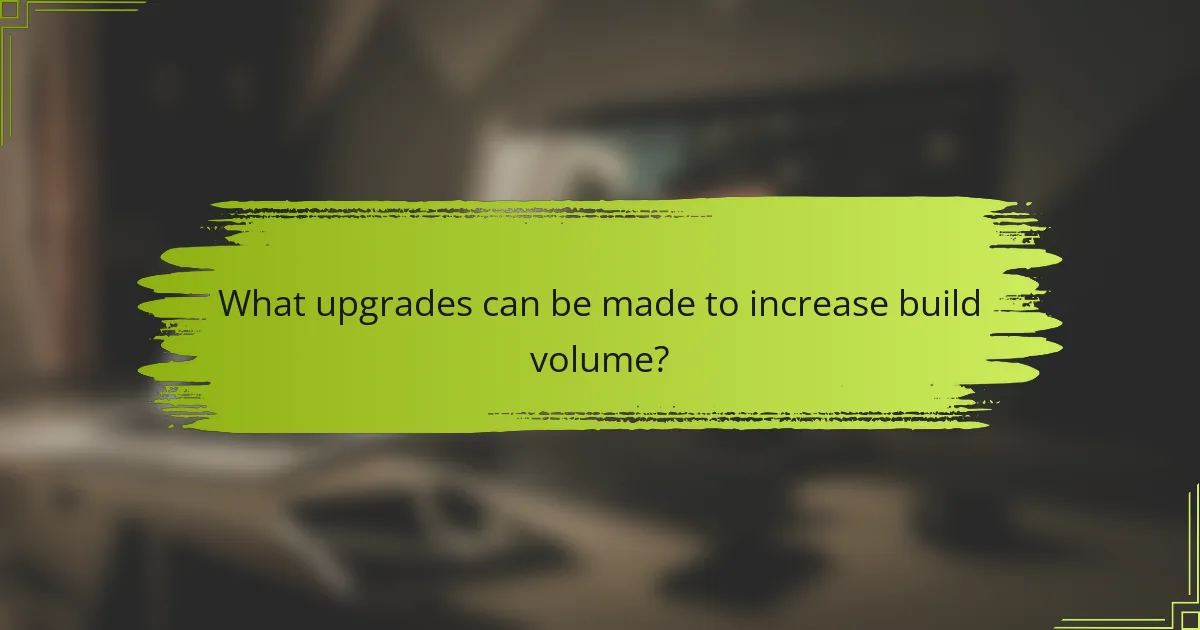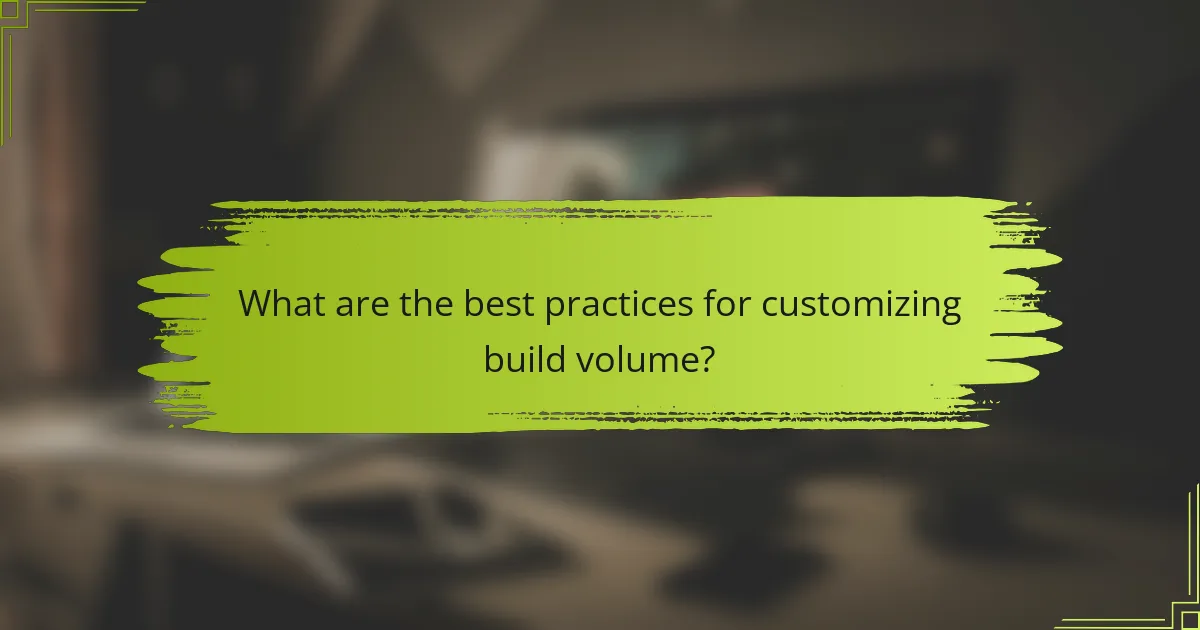
What is Customizing Build Volume for 3D Printers?
Customizing build volume for 3D printers refers to adjusting the size and dimensions of the printing area. This process allows users to create larger or more complex objects than the printer’s default capacity. By modifying hardware components or software settings, users can achieve a tailored build volume. Common methods include upgrading the printer frame, installing a larger print bed, or adjusting firmware settings. Customizing build volume can enhance the printer’s versatility and expand its capabilities. Users often seek this customization to fulfill specific project requirements or improve efficiency.
How does customizing build volume enhance 3D printing capabilities?
Customizing build volume enhances 3D printing capabilities by allowing users to create larger and more complex objects. A larger build volume accommodates bigger designs without the need for assembly. This flexibility supports a wider range of applications, from prototyping to artistic projects. Customization can also optimize the printer’s performance for specific materials or techniques. For instance, adjusting the build volume can improve layer adhesion and reduce warping. Additionally, it enables the use of multi-material printing. This capability expands creative possibilities and enhances functional applications. Overall, a customized build volume leads to improved efficiency and innovation in 3D printing.
What are the key factors influencing build volume customization?
Key factors influencing build volume customization include printer design, intended applications, and user preferences. Printer design determines the maximum build size based on its structural capabilities. Intended applications, such as prototyping or production, dictate the necessary dimensions for printed objects. User preferences reflect personal needs for specific projects or materials. Additionally, hardware limitations, such as motor capabilities and frame stability, impact customization options. The availability of upgrade kits can also influence how much a user can modify their printer’s build volume. Each of these factors plays a crucial role in determining the effectiveness and feasibility of build volume customization.
How does build volume impact print quality and speed?
Build volume directly affects print quality and speed in 3D printing. A larger build volume allows for more complex and larger prints without the need for assembly. However, larger prints can lead to longer print times due to increased material usage and layer count.
Print quality can be impacted by the printer’s ability to maintain precision over larger areas. Larger prints may experience more warping or misalignment if the printer is not calibrated correctly. In contrast, smaller prints can often be completed faster and with higher fidelity due to reduced material and shorter layer heights.
Research indicates that optimizing build volume can enhance print efficiency. For example, a study by R. S. F. et al. in “Journal of 3D Printing Technology” shows that printers with optimized build volumes can reduce print times by up to 30% while maintaining quality. Thus, the relationship between build volume, print quality, and speed is significant and multifaceted.
Why is build volume important for different 3D printing applications?
Build volume is crucial for 3D printing applications as it determines the maximum size of objects that can be printed. Larger build volumes allow for the creation of bigger prototypes and parts in a single print, reducing the need for assembly. This is particularly important in industries like automotive and aerospace, where large components are often required. Additionally, varying build volumes can accommodate different design requirements. For example, small build volumes are suitable for intricate designs, while larger ones are necessary for bulk production. The flexibility in build volume also supports diverse materials and printing techniques. Ultimately, the right build volume enhances efficiency and innovation in 3D printing projects.
Which industries benefit from larger build volumes?
Industries that benefit from larger build volumes include aerospace, automotive, and medical sectors. The aerospace industry requires large components for aircraft parts and prototypes. Automotive manufacturers utilize larger build volumes for creating full-scale models and functional parts. The medical field benefits by producing custom implants and prosthetics. These industries often demand complex geometries and larger prototypes that standard build volumes cannot accommodate. For instance, Boeing utilizes large 3D printers to produce lightweight structures for aircraft, enhancing efficiency and reducing material waste. Similarly, automotive companies like Ford leverage larger build volumes for rapid prototyping and testing.
How does build volume customization affect material usage?
Build volume customization directly influences material usage in 3D printing. A larger build volume allows for the creation of larger objects, which can lead to increased material consumption. Conversely, customizing the build volume to be smaller can reduce material waste for smaller prints.
Optimizing the build volume can also enhance the efficiency of material usage. For example, adjusting the dimensions to fit the specific object can minimize excess material. Studies show that precise volume adjustments can lead to up to 30% less material waste in certain applications.
Additionally, the customization can facilitate the use of support structures, which may require additional material. However, optimizing the build volume can reduce the need for these supports, further conserving material. Thus, careful customization of build volume plays a critical role in managing and optimizing material usage in 3D printing.

What upgrades can be made to increase build volume?
Upgrades to increase build volume include installing a larger print bed and using a taller frame. A larger print bed allows for more extensive parts to be printed simultaneously. Taller frames accommodate larger objects by providing additional vertical space. Additionally, upgrading to a larger nozzle can improve print speed for bigger items. Modifying the firmware can also enable the printer to utilize the full potential of the hardware. These upgrades have been implemented in various 3D printer models to enhance their capabilities.
How do hardware upgrades affect build volume?
Hardware upgrades can significantly affect the build volume of 3D printers. Upgrading components such as the frame, print bed, or gantry system can increase the maximum dimensions of prints. For instance, a larger frame allows for bigger print areas, while a heated print bed can support larger models without warping. Additionally, improvements in the motion system can enhance precision, enabling larger builds without sacrificing quality. Specific upgrades like a larger nozzle or advanced extruder can also facilitate higher flow rates for bigger prints. Overall, hardware enhancements directly correlate with the potential for increased build volume in 3D printing.
What types of frame modifications are available?
Frame modifications for 3D printers include various types such as structural reinforcements, frame extensions, and material upgrades. Structural reinforcements enhance stability and reduce vibrations during printing. Frame extensions increase the overall build volume by adding length or width. Material upgrades often involve replacing the stock frame with aluminum or steel for improved durability. These modifications can significantly impact print quality and printer longevity.
How can nozzle and hotend upgrades expand build volume?
Nozzle and hotend upgrades can expand build volume by allowing for higher flow rates and improved thermal management. An upgraded nozzle can increase the diameter, enabling faster extrusion of material. This results in quicker layer deposition and reduced print times, effectively maximizing the use of the printer’s build area.
Hotend upgrades can enhance temperature control, allowing for a wider range of filament types. This flexibility means users can print larger and more complex models without the risk of clogging or material issues. Additionally, improved hotends can maintain consistent temperatures, leading to better adhesion and layer bonding.
Ultimately, these upgrades facilitate more efficient use of the printer’s capabilities, enabling users to take full advantage of the available build volume.
What software modifications can assist in customizing build volume?
Software modifications that assist in customizing build volume include adjusting firmware settings and slicing software parameters. Firmware modifications, such as Marlin, allow users to redefine the printer’s physical dimensions. This ensures the printer recognizes the new build area accurately. Slicing software like Cura or PrusaSlicer enables users to set custom print areas within the software. These programs allow for the adjustment of model positioning and scaling to fit the modified build volume. Additionally, users can create custom profiles that reflect the new dimensions for future prints. This ensures consistency and accuracy in print jobs. Overall, these modifications enhance the printer’s capability to utilize the full build volume effectively.
How does firmware play a role in build volume adjustments?
Firmware controls the parameters that define the build volume in 3D printers. It interprets the physical dimensions set by the hardware and translates them into operational limits. Adjustments to the firmware can change the printer’s maximum and minimum dimensions. This allows users to customize the build volume according to their needs. For example, modifying firmware settings can enable a printer to accommodate larger or smaller print sizes. The firmware communicates with the printer’s hardware to ensure that movements remain within these defined limits. Accurate firmware settings are essential for preventing collisions and ensuring print quality. Therefore, firmware plays a crucial role in both defining and adjusting the build volume for optimal performance.
What slicing software options support custom build volumes?
Cura, PrusaSlicer, and Simplify3D are slicing software options that support custom build volumes. Cura allows users to define printer dimensions and modify build volume settings. PrusaSlicer offers advanced configuration for custom printer profiles and build areas. Simplify3D provides extensive options for setting up unique build volumes tailored to specific printers. Each software has been widely adopted by the 3D printing community for its flexibility and customization capabilities.

What are the best practices for customizing build volume?
To customize build volume effectively, ensure compatibility with your 3D printer model. Measure the existing build area accurately to determine potential expansion. Select a larger build plate that fits your printer’s specifications. Use a firm mounting method to secure the new plate. Adjust firmware settings to recognize the new dimensions. Test the printer with calibration prints to confirm accuracy. Monitor print quality closely during initial uses to identify any issues. Regularly maintain the printer to ensure consistent performance after modifications.
How can users ensure safety during build volume upgrades?
Users can ensure safety during build volume upgrades by following specific protocols. First, always power down the 3D printer before starting any upgrades. This prevents electrical hazards. Second, disconnect the printer from the power source to eliminate any risk of accidental activation. Third, use appropriate tools and protective gear, such as gloves and safety glasses, to protect against injuries. Fourth, consult the manufacturer’s manual for specific instructions related to upgrades. This ensures compliance with safety guidelines. Finally, check for loose wires or connections after the upgrade to prevent malfunction. Adhering to these steps significantly reduces the risk of accidents during the upgrade process.
What precautions should be taken when modifying printer frames?
When modifying printer frames, ensure to power off the printer and unplug it. This prevents electrical hazards during modifications. Use appropriate tools to avoid damaging components. Verify the frame’s material compatibility with modifications to maintain structural integrity. Measure dimensions accurately to prevent misalignment. Secure all parts firmly to avoid vibrations during operation. Check for any loose wires or connections after modifications. Test the printer thoroughly before resuming regular use to ensure safety and functionality.
How can users avoid common pitfalls in build volume customization?
Users can avoid common pitfalls in build volume customization by carefully measuring their printer’s capabilities. Accurate measurements ensure that the desired modifications do not exceed the printer’s limits. Users should also consider the impact of increased build volume on print quality. Larger volumes may lead to issues such as warping or uneven extrusion.
Additionally, selecting appropriate materials is crucial. Some materials may not perform well in larger volumes. Users should research compatibility before proceeding with modifications. It is also essential to maintain proper calibration after any changes. Regular calibration helps maintain print accuracy and quality.
Finally, users should consult community forums or manufacturer guidelines. These resources often provide valuable insights and advice from experienced users. Following these steps can significantly reduce the likelihood of encountering issues during build volume customization.
What tips can enhance the effectiveness of build volume modifications?
To enhance the effectiveness of build volume modifications, ensure proper calibration of the printer. Accurate calibration prevents issues like layer misalignment. Additionally, utilize high-quality materials to maintain structural integrity during print jobs. Selecting the right nozzle size can optimize flow rates for larger prints. Implementing a heated bed can improve adhesion and reduce warping. Regularly maintain the printer to ensure all components function smoothly. Using slicer software effectively can help manage print settings for larger volumes. Lastly, consider the design of the printed object to maximize the use of available space.
How can users optimize their printing process after upgrades?
Users can optimize their printing process after upgrades by recalibrating their 3D printer settings. This includes adjusting the print speed, temperature, and layer height based on the new hardware capabilities. Testing different filament types can also enhance print quality. Regular maintenance of the printer, such as cleaning the nozzle and bed, is essential for consistent results. Utilizing slicing software effectively can improve the efficiency of the printing process. Monitoring print jobs closely during the initial runs helps identify any issues early on. Finally, engaging with user communities can provide valuable insights and tips for further optimization.
What maintenance practices are essential post-customization?
Essential maintenance practices post-customization include regular calibration, cleaning, and software updates. Calibration ensures that the 3D printer operates accurately after modifications. Cleaning removes debris and dust, which can affect print quality. Software updates optimize performance and fix potential bugs. Checking for loose components helps maintain structural integrity. Regular inspections of the extruder and hotend prevent clogs and overheating. Monitoring filament quality contributes to consistent printing results. These practices enhance the longevity and efficiency of the customized 3D printer.
Customizing build volume for 3D printers involves adjusting the size and dimensions of the printing area to enhance capabilities and accommodate larger or more complex objects. Key factors influencing this customization include printer design, intended applications, and user preferences. The article explores how build volume impacts print quality and speed, the industries that benefit from larger volumes, and the various upgrades available such as hardware modifications, nozzle enhancements, and software adjustments. Additionally, best practices for effective customization and maintenance post-upgrade are discussed to ensure optimal performance and efficiency in 3D printing projects.